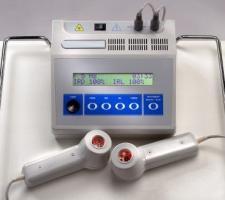Wound Modalities Utilized in Wound Care: Promising Modalities Used Less Commonly
In this series, we have been focusing on wound care modalities that are commonly used in wound care management. Now we turn our focus to lesser known and less common wound care tactics.
Monochromatic Infrared Energy (MIRE)
Monochromatic Infrared Energy (MIRE) involves the delivery of near-infrared energy to the skin using diode pads. This therapy is thought to increase blood flow to the area being treated, which improves tissue perfusion, improves tissue oxygenation, increases nitric oxide formation and increases cell proliferation. Research has shown that patients with neuropathic ulcers benefit the most from this therapy, although it has also been used with success on arterial and venous insufficiency ulcers and pressure ulcers. This technology has been approved by the FDA, but only to decrease wound pain and increase circulation, not as a means to improve wound healing. As such, this therapy may not be reimbursable.
Noncontact Normothermic Wound Therapy (NNWT)
Another less common wound care tactic is Noncontact Normothermic Wound Therapy (NNWT). NNWT combines the principle of moist wound healing with warming of the wound bed in an effort to increase oxygen tension and blood flow to the wound area. A heating element (which is removable) is added to a moisture retentive dressing to increase the temperature of the wound bed to 38°C, which enhances the proliferative and inflammatory phases of wound healing. This therapy has been used on a wide array of wound types, and healing rates twice that of control groups have been reported; in addition, this therapy has been shown to reduce colonization with MRSA. However, much more research is needed before this therapy becomes a mainstay of treatment.
Laser Therapy
Laser therapy has shown promise as a method of enhancing and stimulating wound healing. In wound care, low-intensity laser therapy using gallium-arsenide or helium-neon has been used successfully to treat neuropathic, pressure and venous insufficiency ulcers. Laser therapy is reportedly effective in increasing collagen and protein synthesis, increasing cell proliferation, increasing the rate of epithelialization, enhancing angiogenesis, increasing wound tensile strength: “LLLT is believed to promote wound healing by inducing the local release of cytokines, chemokines, and other biological response modifiers that reduce the time required for wound closure, and increase the mean breaking strength of the wound” (Chung et al, 2012). Laser therapy is also thought to have a bactericidal effect. However, much research needs to be done to support the use of laser therapy in wound healing, as some studies have found no difference in healing between wounds treated with laser therapy and wounds treated using traditional therapies. The use of laser therapy is still considered experimental.
Ultraviolet – Another Less Common Wound Care Tactic
We know that ultraviolet light has been used to treat psoriasis. Recent studies have focused on the use of ultraviolet light to treat wounds, including chronic wounds. The bactericidal effects of ultraviolet light have also been recognized: “UVC (200–280 nm) is highly antimicrobial and can be directly applied to acute wound infections to kill pathogens without unacceptable damage to host tissue” (Gupta et al, 2013). UV light has been shown to enhance wound healing in patients with arterial and venous insufficiency ulcers, as well as diabetic ulcers. As with all of the other wound modalities discussed here, more research is needed to determine whether ultraviolet therapy will take its place among the better-known and accepted wound care treatment modalities.
This ends our examination of wound care modalities and their uses in wound care management. Have you had personal experience with any of the modalities we have discussed? Please share your experiences and feedback—we’d love to hear from you! If you are interested in learning more about wound care or becoming wound care certified, please visit us at Wound Educators.
Source:
Meyers, B (2008). Wound Management: Principles and Practice. 2nd edition. Pearson Prentice Hall. Upper Saddle River, New Jersey. pg. 180-182.
Gupta, A., Avci, P., Dai, T., Huang, Y.-Y., & Hamblin, M. R. (2013). Ultraviolet Radiation in Wound Care: Sterilization and Stimulation. Advances in Wound Care, 2(8), 422–437. http://doi.org/10.1089/wound.2012.0366
Chung, H., Dai, T., Sharma, S. K., Huang, Y.-Y., Carroll, J. D., & Hamblin, M. R. (2012). The Nuts and Bolts of Low-level Laser (Light) Therapy. Annals of Biomedical Engineering, 40(2), 516–533. http://doi.org/10.1007/s10439-011-0454-7

